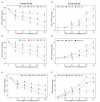The Antifungal Activity of Loquat (Eriobotrya japonica Lindl.) Leaves Extract Against Penicillium digitatum
- PMID: 34490318
- PMCID: PMC8417588
- DOI: 10.3389/fnut.2021.663584
The Antifungal Activity of Loquat (Eriobotrya japonica Lindl.) Leaves Extract Against Penicillium digitatum
Abstract
This study was performed to determine the antifungal activity of loquat (Eriobotrya japonica Lindl) leaf extract (LLE) against the citrus postharvest pathogen Penicillium digitatum (P. digitatum). The LLE exhibited an antifungal activity against P. digitatum, with a minimum inhibitory concentration (MIC) of 0.625 mg/ml and a minimum fungicidal concentration (MFC) of 1.25 mg/ml. Significant inhibitory effects of LLE on mycelial growth and spore germination of P. digitatum were seen in a dose-dependent manner. Simultaneously, to investigate possible antifungal mechanisms by LLE, we analyzed their influence on morphological changes, cell membrane permeability, cell wall and cell membrane integrity, and adenosine phosphates (ATP, ADP, and AMP) levels. Alterations, such as sunken surface and malformation, occurred in the LLE-treated P. digitatum spores. Furthermore, intracellular inclusion content decreased after LLE treatment, indicating an increase in cell membrane permeability. Besides, the LLE treatment induced a significant decline in the level of adenosine monophosphate (AMP), adenosine diphosphate (ADP), and adenosine triphosphate (ATP) with a noticeable addition of extracellular ATP, ADP, and AMP during the entire treatment period. Overall, the results manifested that the antifungal activity of LLE against P. digitatum can be attributed to the derangement of cell membrane permeability and disordered energy metabolism. This is the first report on the mechanism of antifungal activity of LLE and could be useful in the development of targeted fungicides from natural origin.
Keywords: Penicillium digitatum; antifungal activity; energy metabolism; loquat leaves; membrane permeability.
Copyright © 2021 Shen, Chen, Cai, Yang, Chen, Kahramanoǧlu, Okatan, Rengasamy and Wan.
Conflict of interest statement
The authors declare that the research was conducted in the absence of any commercial or financial relationships that could be construed as a potential conflict of interest.
Figures






Similar articles
-
Antofine inhibits postharvest green mold due to imazalil-resistant Penicillium digitatum strain Pdw03 by triggering oxidative burst.J Food Biochem. 2021 Jun;45(6):e13751. doi: 10.1111/jfbc.13751. Epub 2021 May 5. J Food Biochem. 2021. PMID: 33949723
-
p-Anisaldehyde Exerts Its Antifungal Activity Against Penicillium digitatum and Penicillium italicum by Disrupting the Cell Wall Integrity and Membrane Permeability.J Microbiol Biotechnol. 2019 Jun 28;30(6):878-884. doi: 10.4014/jmb.1911.11032. J Microbiol Biotechnol. 2019. PMID: 32160698 Free PMC article.
-
Influence of α-terpineol on the growth and morphogenesis of Penicillium digitatum.Bot Stud. 2015 Dec;56(1):35. doi: 10.1186/s40529-015-0116-4. Epub 2015 Dec 13. Bot Stud. 2015. PMID: 28510844 Free PMC article.
-
γ-Cyclodextrin encapsulated thymol for citrus preservation and its possible mechanism against Penicillium digitatum.Pestic Biochem Physiol. 2023 Aug;194:105501. doi: 10.1016/j.pestbp.2023.105501. Epub 2023 Jun 14. Pestic Biochem Physiol. 2023. PMID: 37532321
-
Biological Activities of Extracts from Loquat (Eriobotrya japonica Lindl.): A Review.Int J Mol Sci. 2016 Dec 6;17(12):1983. doi: 10.3390/ijms17121983. Int J Mol Sci. 2016. PMID: 27929430 Free PMC article. Review.
Cited by
-
Effect of Galangal Essential Oil Emulsion on Quality Attributes of Cloudy Pineapple Juice.Front Nutr. 2021 Nov 19;8:751405. doi: 10.3389/fnut.2021.751405. eCollection 2021. Front Nutr. 2021. PMID: 34869525 Free PMC article.
-
Anti-Fungal Activity of Moutan cortex Extracts against Rice Sheath Blight (Rhizoctonia solani) and Its Action on the Pathogen's Cell Membrane.ACS Omega. 2022 Dec 7;7(50):47048-47055. doi: 10.1021/acsomega.2c06150. eCollection 2022 Dec 20. ACS Omega. 2022. PMID: 36570206 Free PMC article.
-
Exogenous Nitric Oxide Induces Pathogenicity of Alternaria alternata on Huangguan Pear Fruit by Regulating Reactive Oxygen Species Metabolism and Cell Wall Modification.J Fungi (Basel). 2024 Oct 19;10(10):726. doi: 10.3390/jof10100726. J Fungi (Basel). 2024. PMID: 39452678 Free PMC article.
-
Antifungal Activity of Ethanolic Extracts from Aeroponically Grown Cape Gooseberry (Physalis peruviana L.) with LED Lights and In Vitro Habituated Roots.Plants (Basel). 2024 Dec 23;13(24):3586. doi: 10.3390/plants13243586. Plants (Basel). 2024. PMID: 39771284 Free PMC article.
-
Phytochemicals, Extraction Methods, Health Benefits, and Applications of Loquat (Eriobotrya japonica Lindl.) and Its By-Products: A Comprehensive Review.Food Sci Nutr. 2025 Jul 1;13(7):e70483. doi: 10.1002/fsn3.70483. eCollection 2025 Jul. Food Sci Nutr. 2025. PMID: 40599359 Free PMC article. Review.
References
-
- Erasmus A, Lennox CL, Korsten L, Lesar K, Fourie PH. Imazalil resistance in Penicillium digitatum and P. italicum causing citrus postharvest green and blue mould: impact and options. Postharvest Biol Technol. (2015) 107:66–76. 10.1016/j.postharvbio.2015.05.008 - DOI
-
- Kellerman M, Erasmus A, Cronjé PJR, Fourie PH. Thiabendazole residue loading in dip, drench and wax coating applications to control green mould and chilling injury on citrus fruit. Postharvest Biol Technol. (2014) 96:78–87. 10.1016/j.postharvbio.2014.05.008 - DOI
LinkOut - more resources
Full Text Sources

